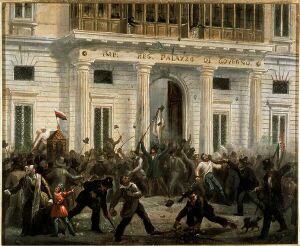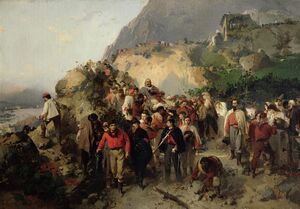Montanaro Rebellion
This page is currently undergoing major reconstruction in accordance with broader lore changes. |
| First Montanaran Rebellion | |||||||
|---|---|---|---|---|---|---|---|
| Part of Girojon Restoration | |||||||
 Montanaran revolutionaries storming the Governor's Palace | |||||||
| |||||||
| Belligerents | |||||||
|
|
| ||||||
| Commanders and leaders | |||||||
| |||||||
The First Montanaran Rebellion (Montanaroan: Rebelia ditu MDCCCXXIII; Pelaxian: Primera Rebelión Montañerán) is the name of the first major rebellion in the Pelaxian province of Montanaro which lasted from 1823 until 1825. The conflict emerged as a result of the restoration of the Girojon monarchy in Pelaxia, ending the First Republic, and the suppression of Montanaran autonomy which was expanded by the First Republic. It is the only major armed conflict to have emerged on the Pelaxian mainland during the Girojon Restoration period as all other conflicts during this period were in the colonies in Vallos. Since the rise of modern Montanaro nationalism in the mid-to-late 20th Century, rebellion is widely commemorated in public spaces throughout Montanaro. Because of the rebellion, Montanaro as a province was dissolved by King Fernando I in an effort to divide and conquer the Montanaran areas; these divisions were undone during the period of the Second Republic with the united province of Montanaro being officially restored.
Background
The rebellion came after almost a decade into the Girojon Restoration. Prior to the Restoration, the Montanarans, a Slavic ethnic group closely related to the Volonians, were given numerous political and civil rights under the First Pelaxian Republic and even sweeping autonomy for the province of Montanaro, making it the first time that the Pelaxian state would recognise the Montanarans as being a distinct nation within the country. Upon the restoration of the Girojon monarchy in 1814, King Fernando I, fearing that an autonomous Montanaro would prove to be a persistent roadblock for his ambitions, would unilaterally strip Montanaro's autonomy. The Montanaran government, having not been consulted nor consented to this revocation of autonomy, refused to acknowledge King Fernando I's revocation of autonomy and instead continued to govern themselves under the now-revoked autonomy. This resulted in Fernando I sending out a garrison into Montanaro to forcibly remove the autonomous government in power and replace them with the traditional provincial government that all other Pelaxian provinces had.
To further ensure Montanaro's loyalty to Pelaxia, Fernando I also incentivised Pelaxians to settle in the province by promising them free farmland. This allowed for an influx of Pelaxians to settle in Montanaro, much to the chagrin and frustration of the Montanarans who feared that they would be assimilated into the Pelaxian culture and converted to the Latin Church. These feelings would see an increase in calls amongst the Montanarans for Fernando I to relinquish further power to the legislature, which was largely sympathetic to the Montanarans, or abdicate in favour of his more reform-minded cousin Miguel-Alfonso. As a staunch royal traditionalist, Fernando I rejected both the calls for further relinquishment of power and the calls for abdication and instead took an extremely heavy-handed approach in suppressing the Montanarans such as banning them from speaking their own language out in public and forcibly closing Caphiric Rite churches under the belief that they were used for clandestine meetings by nationalists.
The suppression reached its most brutal extent in 1822 when a garrison of the Royal Pelaxian Army massacred a Montanaran nationalist demonstration against the constant and increasing repression of their culture and identity. This massacre, known as the Procession of the Martyrs, became a rallying point for further acts of rebellion against the Pelaxian state and for the eventual rise in calls to secede from Pelaxia as an independent "Latino-Slavic" state which would see not only Montanaran independence from Pelaxia, but also the rise in irredentist rhetoric which would include not only the traditional and current homelands of the Montanarans, but also the lands of the Volonians, at the time under Caphiric rule, which had also been experiencing a rise in nationalist sentiment.
Call to Arms

The initial date for what would become the first spark of the rebellion was on 3 May 1803 when peasants, incensed by the migration of Pelaxian settlers who took up farmland for free while they were forced to toil in those same lands, and even some sympathetic nobles, who felt that their rights were being encroached upon by the revocation of autonomy, gathered at the provincial capital of Hoarnauã. What exactly caused the initial strike to storm the palace of the Montanaran governor is currently unknown as much of the historiography on the rebellion were first compiled in the 1930s, over a century after the end of the rebellion. Regardless, it is widely agreed that the storming of the governor's palace, and the flight of Governor Javier de Poliñac, was what began the rebellion with the Montanaran Republic being declared shortly thereafter.
Cnamulta spoke to the Montanaros from the balcony after the death of Luppi, and told the Montanaros to spread the word of what had happened there to rally more Montanaros to their cause. The word quickly spread across Montanaro country, with smaller revolts happening all across the country where local garrisons were overwhelmed and arms caches raided. The inhabitants of rural Montanaro country kept contact with Cnamulta's government to a minimum and took part in guerrilla warfare, whilst Cnamulta's rebels initially fought with conventional warfare, trained by Crexu and Shertre Auxanei, both who were graduates of the Imperial Academy and defectors of the Imperial Army. The first victory of the rebellion was following the brief siege of Arastergore, where the Acirian garrison lead by Plecur Nusce not only surrendered, but joined the rebellion. Nusce lead the first Montanaro brigade, which caused the brigade to almost unanimously agree to join the rebellion.
Evolution of the rebellion
Internal conflicts
Due to the vastly differing backgrounds of the leading rebels, they often bickered and argued over how the eventual Montanaro nation should be lead. Cnamulta was raised not only in nobility but as very religious, so she believed it was only natural for the coming nation to be a Kingdom. She thought that due to her invaluable efforts in starting the rebellion were grounds for her to be the Queen of the nation, and it was her Godgiven right. Macutne was the only one to support her, while he supported a Kingdom with her at the lead, he wanted to limit the crown's powers with the establishment of a constitutional monarchy. Crexu and Auxanei were the supporters of the Montanaro Republic based around the former Free Republic of Aciria, which was the placeholder form of government during the rebellion. Nusce wanted a confederacy lead by a figurehead leader with little power, only there to unite the Montanaros if Acirians ever returned to reclaim Montanaro country.
These differences were not the only differences the leaders of the rebellion had, with some leader advocating and practising guerrilla warfare while others wanted to follow conventional warfare. These differences in the leadership eventually caused cracks in the rebellion which indirectly caused the collapse of the leadership. The eventual death of Nusce and Macutne alongside with the loss of territory that followed shortly after caused a drastic drop in morale in the ranks of the rebellion, causing some desertions and infighting, which lead to the figurehead leader of the rebellion, Cnamulta, spending more and more time trying to raise morale and keep the armies together and cohesive.
Battles
The rebellion enjoyed great initial success in battles all over Montanaro country, partially thanks to the unprepared garrisons and the overwhelming numbers of Montanaros taking part in the rebellion. Despite the lack of firearms in most of the Montanaro forces, they managed to beat their more well-equipped Acirian counterparts due to their knowledge of the terrain and notable marksmanship with bows. It was during the Montanaro Rebellion when the Montanaro archery became well known all across Aciria.
Following the death of Luppi, Remigno Pirassina became as the Marshal of Aciria, and took the responsibility of military operations against the Montanaros. Pirassina's campaigns were disastrous due to effective Montanaro interception of supply and communications between troops, which eventually caused Giovanni I to appoint Decilindo Barbone as Luppi's successor and sent Barbone to Chegallari with a brigade of Imperial Guards. Battle of Chegallari became the first major loss to the rebellion, losing not only the home of the rebellion but also both leaders Nusce and Macutne died in the battle. The capture of Chegallari became the Acirian foothold in the region where Barbone's forces made repeated attempts to reclaim nearby towns and villages, with some success at the cost of morale.

Once the lack of progress reached Trossera, on 19 September 1804 Giovanni I took a brigade of Imperial Army conscripts alongside his personal Imperial Guard brigade and headed for Chegallari. After his arrival there two weeks later, he sent his scouts to map out the region and began planning the Grand Offensive with Barbone and Pirassina. Due to his recently developed back problems, Giovanni stayed back and simply assisted in planning the campaign and providing morale for the troops. In December of 1804 the Grand Offensive was mostly finished, with Giovanni ordering the offensive to start on 1 April 1805, given the snow has melted by then.
Once 1 April 1805 came around and the plan was adjusted according to Giovanni's scouts plans, a massive offensive spearheaded by Imperial Guard was started. The Imperial Guard were expected to punch through the front lines and split the armies, whilst the following conscripts would finish off the separated army and occupy the areas. The Imperial Guard were nearly cut off by June at the Battle of Magligno Pass, where the conscripts came in much later than they were supposed to due to the rough, muddy terrain caused by the weather. The army lead by Auxanei managed to use their knowledge of the terrain to effectively communicate and reunite the shattered army, which was hours away from starting the attack that would've likely resulted in the annihilation of the Imperial Guards. The plan was stopped when the conscripts eventually reached them and broke through, connecting the conscripts with the Imperial Guards once again.
The war came to an end when in August Cnamulta was captured by Barbone's forces. She was brought to Chegallari and executed on the market square, meters away from the location she had hung Luppi from two years prior. The death of Cnamulta signaled the end of the rebellion, and to avoid the shame of public execution, Auxanei reportedly committed suicide and was buried in an unmarked grave somewhere in Montanaro country.
Aftermath
With all leaders of the rebellion dead by the end of the war, the Treaty of Chegallari was signed by the right-hand man of Cnamulta known as Treprexu. The treaty used Treprexu as the leader of the Montanaros, which then caused him to become the Imperial Envoy to the governor of Santa Beatrice by making the Montanaros relinquish all weapons they had taken during the war, pay reparations for the human life and financial losses via taxes and labour and recognition of Acirian rule over Montanaro country.
The war was the first moment in history when Montanaros saw themselves as a unified people instead of clans or tribes, which has been used by Montanaro artists as a source of inspiration for centuries. Historians also see this as the origin of the Montanaro autonomy and independence movement.